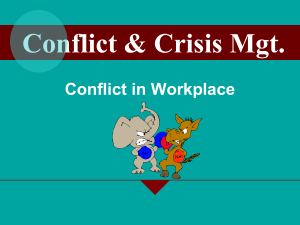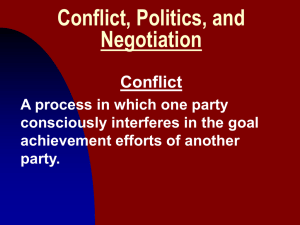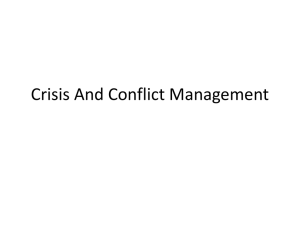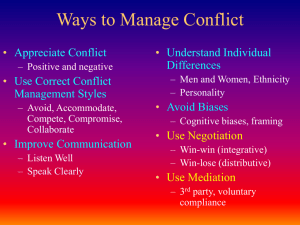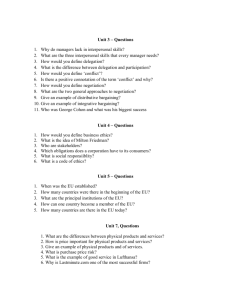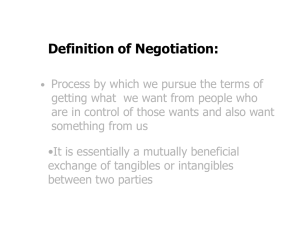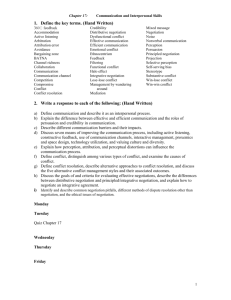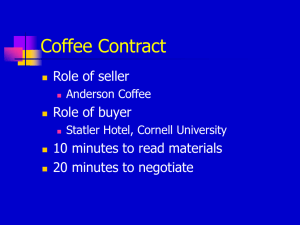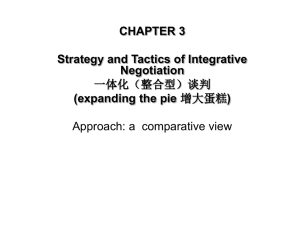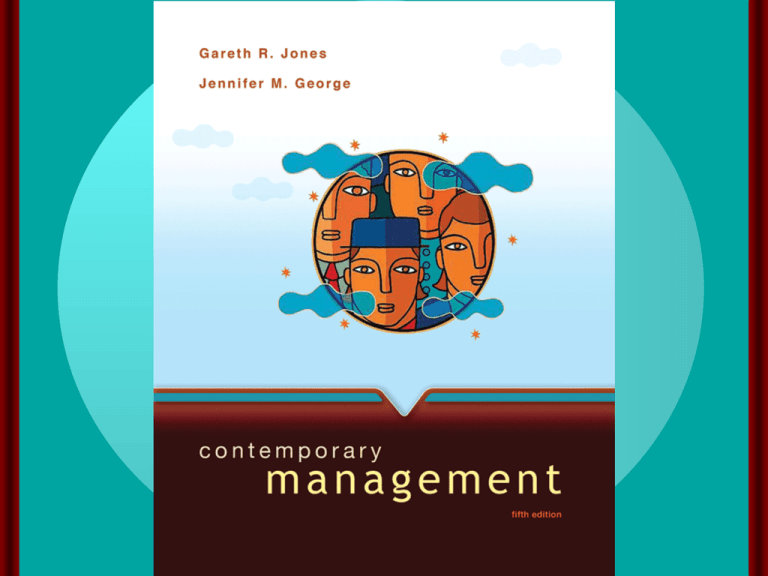
chapter seventeen
Managing Conflict, Politics,
and Negotiation
McGraw-Hill/Irwin
Contemporary Management, 5/e
Copyright © 2008 The McGraw-Hill Companies, Inc. All rights reserved.
Learning Objectives
• Explain why conflict arises, and identify
the types and sources of conflict in
organizations.
• Describe conflict management strategies
that managers can use to resolve conflict
effectively.
• Understand the nature of negotiation and
why integrative bargaining is more
effective than distributive negotiation.
17-3
Learning Objectives
• Describe ways in which managers can
promote integrative bargaining in
organizations
• Explain why managers need to be
attuned to organizational politics, and
describe the political strategies that
managers can use to become politically
skilled.
17-4
Organizational Conflict
• Organizational Conflict
– The discord that arises when goals,
interests or values of different individuals or
groups are
incompatible
and those people
block or thwart
each other’s efforts
to achieve their
objectives.
17-5
Organizational Conflict
• Organizational Conflict
– Conflict is inevitable given the wide range of
goals for the different stakeholder in the
organization.
17-6
The Effect of Conflict on Organization
Performance
Figure 17.1
17-7
Types of Conflict
Figure 17.2
17-8
Types of Conflict
• Interpersonal Conflict
– Conflict between individuals due to
differences in their goals or values.
• Intragroup Conflict
– Conflict within a
group or team.
17-9
Types of Conflict
• Intergroup Conflict
– Conflict between two or more teams, groups
or departments.
– Managers play a key role in resolution of
this conflict
• Interorganizational Conflict
– Conflict that arises across organizations.
17-10
Sources of Conflict
Figure 17.3
17-11
Sources of Conflict
• Different Goals and Time Horizons
– Different groups have differing goals and
focus.
• Overlapping Authority
– Two or more managers claim authority for
the same activities which leads to conflict
between the managers and workers.
17-12
Sources of Conflict
• Task Interdependencies
– One member of a group or a group fails to
finish a task that another member or group
depends on, causing the waiting worker or
group to fall behind.
• Different Evaluation or Reward
Systems
– A group is rewarded for achieving a goal, but
another interdependent group is rewarded
for achieving a goal that conflicts with the
first group.
17-13
Sources of Conflict
• Scarce Resources
– Managers can come into conflict over the
allocation of scare resources.
• Status Inconsistencies
– Some individuals and groups have a
higher organizational status than
others, leading to conflict with lower
status groups.
17-14
Conflict Management Strategies
• Functional Conflict Resolution
– Handling conflict by compromise or
collaboration between parties.
17-15
Conflict Management Strategies
• Compromise
– each party is concerned about their goal
accomplishment and is willing to engage in
give-and-take exchange to reach a
reasonable solution.
• Collaboration
– parties try to handle the conflict without
making concessions by coming up with a
new way to resolve their differences that
leaves them both better off.
17-16
Conflict Management Strategies
• Accommodation
– one party simply gives in to the other party
• Avoidance
– two parties try to ignore the problem and do
nothing to resolve the disagreement
17-17
Conflict Management Strategies
• Competition
– each party tries to maximize its own gain
and has little interest in understanding the
other’s position
17-18
Strategies Focused on Individuals
• Increasing awareness of the sources of
conflict
• Increasing diversity awareness and skills
• Practicing job rotation
• Using permanent transfers or dismissals
when necessary
17-19
Strategies Focused on the Whole
Organization
• Changing an
organization’s
structure or
culture
• Altering the
source of conflict
17-20
Negotiation
• Negotiation
– Parties to a conflict try to come up with a
solution acceptable to themselves by
considering various alternative ways to
allocate resources to each other
17-21
Negotiation
• Third-party negotiator
– an impartial individual with expertise in
handling conflicts
– helps parties in conflict reach an acceptable
solution
17-22
Third-party Negotiators
• Mediators
– facilitates negotiations but no authority to
impose a solution
• Arbitrator
– can impose what he thinks is a fair solution
to a conflict that both parties are obligated
to abide by
17-23
Distributive Negotiation
• Distributive negotiation
– Parties perceive that they have a “fixed pie”
of resources that they need to divide
– Take a competitive adversarial stance
– See no need to interact in the future
– Do not care if their interpersonal relationship
is damaged by their competitive negotiation
17-24
Integrative Bargaining
• Integrative bargaining
– Parties perceive that they might be able to
increase the resource pie by trying to come
up with a creative solution to the conflict
– View the conflict as a win-win situation in
which both parties can gain
– Handled through collaboration or
compromise
17-25
Strategies to Encourage
Integrative Bargaining
• Emphasizing superordinate goals
– goals that both parties agree to regardless
of the source of their conflict
•
•
•
•
Focusing on the problem, not the people
Focusing on interests, not demands
Creating new options for joint gain
Focusing on what is fair
17-26
Organizational Politics
• Organizational Politics
– The activities managers engage in to
increase their power and to use power
effectively to achieve their goals or
overcome resistance or opposition.
17-27
Organizational Politics
• Political strategies
– Specific tactics used to increase power and
use it effectively to influence and gain the
support of other people while overcoming
resistance
17-28
The Importance of Organizational
Politics
• Politics
– Can be viewed negatively when managers
act in self-interested ways for their own
benefit.
– Is also a positive force that can bring about
needed change when political activity allows
a manager to gain support for needed
changes that will advance the organization.
17-29
Political
Strategies
for
Increasing
Power
Figure 17.4
17-30
Political Strategies for Gaining and
Maintaining Power
Strategies
Controlling Uncertainty
Reduce uncertainty for others in the firm
Being Irreplaceable
Develop valuable special knowledge or
skills
Being in a Central
Position
Have decision-making control over the
firm’s crucial activities and resources
Generating Resources
Hire skilled people or find financing when
it is needed
Building Alliances
Develop mutually beneficial relations
with others inside and outside the
organization
17-31
Political
Strategies
for
Exercising
Power
Figure 17.5
17-32
Strategies for Exercising Power
Strategies
Relying on Objective
Information
Providing impartial information causes
others to feel the manager’s course of
action is correct.
Bringing in an Outside
Expert
Using an expert’s opinion to lend
credibility to manager’s proposal
Controlling the Agenda
Influencing those issues included (and
those dropped) from the decision
process.
Making Everyone a
Winner
Making sure that everyone whose
support is needed benefits personally
from providing that support.
17-33

